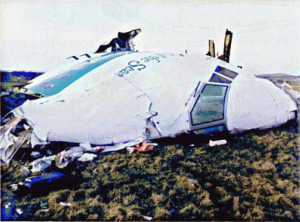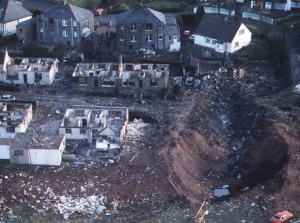Difference between revisions of "Pan Am Flight 103"
(→At the time of the attack: Wikifying) |
|||
| Line 15: | Line 15: | ||
*UK-US relations with Libya were icy over alleged Libyan sponsorship of terrorism and its stubborn refusal to 'see things the West's way'. | *UK-US relations with Libya were icy over alleged Libyan sponsorship of terrorism and its stubborn refusal to 'see things the West's way'. | ||
*UK-US relations with Iran were slated for improvement following the cessation of the Iran Iraq war in which both sides had been armed by the West. | *UK-US relations with Iran were slated for improvement following the cessation of the Iran Iraq war in which both sides had been armed by the West. | ||
| − | * On 3 July 1988 Iran Air Flight 655, a civilian Airbus A300 airliner en-route from Bandar Abbas, Iran to Dubai, UAE was brought down by a missile fired by the US Navy guided missile cruiser USS Vincennes, with the loss of 290 lives. The US government claimed that the Airliner had been mistaken for an attacking F14 Tomcat fighter. <Ref>[http://en.wikipedia.org/wiki/Iran_Air_Flight_655 Wikipedia Page - Iran Air Flight 655]</ref> | + | * On 3 July 1988 [[Iran Air Flight 655]], a civilian Airbus A300 airliner en-route from Bandar Abbas, Iran to Dubai, UAE was brought down by a missile fired by the US Navy guided missile cruiser USS Vincennes, with the loss of 290 lives. The US government claimed that the Airliner had been mistaken for an attacking F14 Tomcat fighter. <Ref>[http://en.wikipedia.org/wiki/Iran_Air_Flight_655 Wikipedia Page - Iran Air Flight 655]</ref> |
====At the time of the trial==== | ====At the time of the trial==== | ||
Revision as of 10:24, 13 May 2013
On 21 December 1988 Pan Am Flight 103, a Boeing 747-21, was on a scheduled transatlantic flight from London Heathrow Airport to New York's John F. Kennedy International Airport when there was an explosion on board. The aircraft broke up over the Scottish town of Lockerbie (Map), killing all 243 passengers and 16 crew members. Eleven people in Lockerbie were killed by large sections of the plane which fell in and around the town, bringing total fatalities to 270.
Thirteen years later, on 31 January 2001, Libyan citizen Abdelbaset Ali Mohmed Al Megrahi was convicted of involvement in the bombing and sentenced to life imprisonment in Scotland. His co-defendant, Lamin Khalifah Fhimah, was unanimously acquitted. In June 2007, Megrahi was granted leave to appeal his conviction, on the basis of evidence that a miscarriage of justice could have occurred. [1] The appeal to the Court of Criminal Appeal was abandoned by al-Megrahi in August 2009, just two days before the Scottish Government released him on compassionate grounds to return to Libya. The stated grounds for release were that he was suffering from terminal prostate cancer and was likely to die within three months.
Contents
- 1 Background
- 2 The Investigation
- 3 The Trial
- 4 The Official Narrative
- 5 Two key elements in the al-Megrahi conviction
- 6 Evidence withheld or not available at the time of the trial
- 7 Post-Trial developments
- 8 Alternative Possibilities
- 9 South African Apartheid Regime
- 10 See Also
- 11 Video
- 12 References
Background
Geopolitical considerations
At the time of the attack
- UK-US relations with Libya were icy over alleged Libyan sponsorship of terrorism and its stubborn refusal to 'see things the West's way'.
- UK-US relations with Iran were slated for improvement following the cessation of the Iran Iraq war in which both sides had been armed by the West.
- On 3 July 1988 Iran Air Flight 655, a civilian Airbus A300 airliner en-route from Bandar Abbas, Iran to Dubai, UAE was brought down by a missile fired by the US Navy guided missile cruiser USS Vincennes, with the loss of 290 lives. The US government claimed that the Airliner had been mistaken for an attacking F14 Tomcat fighter. [2]
At the time of the trial
- UK-US relations with Libya were being 'normalised' following Libya's agreement to extradite al-Megrahi for trial and its abandonment of its allegedly belligerent stance over previously core issues of policy on trade, oil and support for groups antagonistic to Western interests. The accommodation resulted in the lifting of UN trade sanctions against Libya which had progressively paralyzed its economy over the preceding decade.
- UK-US relations with Iran were close to all-time lows and deteriorating over the usual issues of Iranian refusal to 'see things the West's way'
The Investigation
The people and organisations involved
Investigation anomalies
The Trial
- Lockerbie: The Truth is finally coming out. - Post by Michael Meacher MP on his blog (since removed) and reposted on Robert Black's blog. It alleges bribery of the chief prosecution witness with the collusion of Strathclyde police and the US Authorities.
Trial Anomalies
Personalities central to the investigation and prosecution case
- Vincent Cannistraro - CIA task force officer in the brutal 1980s Iran-Contra campaign. Deployed a training manual of invasion and killing of Nicaraguan citizens and officials. Wrote "the anatomy of a lie" to cover up US government involvement in Nicaragua. In 1986 was commissioned by the US President to "Destabilize Libya and destroy the Gaddafi regime". Secretly worked to arm the Afghanistan Mujahadeen and Osama Bin Laden. His chief Admiral Poindexter chaired a top-level meeting - to which Cannistraro had access - to discuss the manufacture of evidence to destabilize the government of Yemen. Head of the CIA Lockerbie team, but did not attend the trial to give evidence.
- Thomas Thurman - FBI Laboratory 'scientist'.
- Alan Feraday - Former head of the forensic laboratory at Royal Armaments Research and Development Establishment (RARDE) at Fort Halstead.
- Dr Thomas Hayes - Over the 1970s and early 1980s progressed to head the RARDE forensic laboratory. His testimony was central to the Lockerbie verdict. Yet he and two colleagues conspired to with-hold evidence from the 1974 alleged IRA Maguire Seven trial which would have indicated innocence. The Maguires were freed on appeal after fifteen years in jail. This matter was exposed in the Lockerbie trial, but the judges trusted Hayes' word implicitly.
The Official Narrative
Two key elements in the al-Megrahi conviction
- The identification of Al-Megrahi: In an extraordinary development in 2005, Maltese shopkeeper Toni Gauci was exposed as an unreliable witness by the man who in 1991 indicted Megrahi, former Scottish Lord Advocate Peter Fraser. In Fraser's words, Gauci was "an apple short of a picnic." And yet the judges trusted Gauci's contradictory and confused evidence, and ignored the fact that Gauci was on a promise of a multi-million dollar reward if Al-Megrahi was convicted. It is now documented and proven that Gauci was paid at least $2 million for his evidence, and his brother Paul $1 million.
- The alleged bomb timer fragment: Was it planted to frame Libya for the crime? The fragment's label had been altered by unknown persons. And its finding and examination by Dr Thomas Hayes proved highly suspicious. A series of scientific tests in 2009 have proved that its survival two centimetres from the centre of a high explosive fireball was impossible.[3]
Evidence withheld or not available at the time of the trial
- Former CIA agent, Robert Baer, CIA Middle Eastern specialist, worked on the early stages of the investigation. He has repeatedly claimed that, in 1989, there was "Grade A intelligence" held by America to prove that Iran requested and paid for the Lockerbie bombing. If Baer is correct, then the bomb timer fragment which pointed to Libya must have been planted.
- Lord Peter Fraser, Scotland's Chief Law Officer during the investigation and indictments, claimed in 1991 that witnesses would "prove the case beyond reasonable doubt." In 2005 he admitted to journalists that his chief witness Gauci was highly unreliable. Then in 2008, when questioned by a Times journalist, Fraser indicated suspicions that key evidence might have been planted with the knowledge of the CIA.
- Shukri Ghanem, Libyan Prime Minister 2003 - 2006, has said, on at least two occasions in radio and television interviews, that Libya was not responsible and it paid the $2.7 billion compensation with great reluctance and only "to buy peace and move forward."
Post-Trial developments
al-Megrahi's release on compassionate grounds
Alternative Possibilities
Iranian sponsored operation
CIA Involvement
South African Apartheid Regime
President P W Botha ruled apartheid South Africa between 1978 and 1989 and was responsible for gross human rights violations, including all the violence that was sanctioned by the State Security Council (SSC), an executive organ of his apartheid regime. Such violence included using torture, abduction, arson and sabotage, and murdering those opposed to apartheid.[4] An SSC subcommittee, chaired by ‘superspy’ Major Craig Williamson, targeted anti-apartheid groups and individuals.[5]
From Chequers to Lockerbie
The distance by road from Chequers, the Prime Minister’s country residence in Buckinghamshire, to the site in Scotland of the Pan Am Flight 103 crash on 21 December 1988 is 310 miles. It took more than 4½ years for President P W Botha to complete his murderous journey from meeting Margaret Thatcher at Chequers on 2 June 1984 to the sabotage at Lockerbie.[6]
The full article "From Chequers to Lockerbie" by Patrick Haseldine can be read here.
- Comments from Patrick Haseldine on Robert Black's Blog - 6 October 2009
See Also
On WikiSpooks
- A MUST READ - File:The Framing of al-Megrahi.doc - An article by Gareth Pierce from the London Review of Books - September 2009.
- UN Report on the first Lockerbie case appeal Professor Hans Koechler Vienna 26 March 2002
- How Megrahi and Libya were framed for Lockerbie - Alexander Cockburn in "The First Post" July 2010
- Bomber, Bomber, Bomber - Steven Raeburn of "The Firm", a Scottish Lawyers Web Site
- The Lockerbie case and the corruption of justice - Dr Hans Koechler
- Release of the Lockerbie Prisoner - Dr Hans Koechler
- The Lockerbie case and the corruption of justice - Dr Hans Koechler
- The Syrian Connection - David Guyatt
- Lockerbie: Ayatollah's Vengeance Exacted by Botha's Regime - Patrick Haseldine
External sites
- A 'MUST CONSULT' RESOURCE - The Herald, Scotland - Lockerbie archive - A substantial Establishment-sceptic resource.
- A 'MUST CONSULT' RESOURCE - - ohmynews - list of articles on the Lockerbie Bombing
- Scottish Law Reporter. Lockerbie pages
- Lockerbie - The evidence
- Flight From the Truth - The Guardian 27 June 2001
- Jim Swire's Web Site
- Facebook group: U.N. must investigate the targeting of Bernt Carlsson on Pan Am Flight 103
- Professor Robert Black's Blog
- Crown Fights to keep 48 pieces of evidence secret - Glasgow Herald 19 February 2010
- Questions remain over Lockerbie - Guardian letters 23 July 2010
- Lockerbie witness 'put up for reward'
- Lockerbie Bombing Case Faces U-Turn after Perjury Confession - Sofia News Agency 20 August 2007
- UN Claims Lockerbie Trial Was Rigged - Common Dreams 8 April 2001 from The Glasgow Herald
- WikiPedia - Pan Am Flight 103 page
Video
- Lockerbie Lies - A Youtube video featuring Professor Robert Black who was largely responsible for the setup of the Hague Trial and believes that Megrahi would be aquitted in any retrial.
- "The Lockerbie Bombing - Pan Am Flight 103" Al-Jazeera TV documentary featuring Professor Robert Black and Dr John Cameron.
References
- ↑ File:SCCRC-Lockerbie.pdf - SCCRC Leave to appeal decision press release - June 2007
- ↑ Wikipedia Page - Iran Air Flight 655
- ↑ The two key elements of al-Megrahi's conviction
- ↑ South African Truth and Reconciliation Commission
- ↑ Interview with SA 'superspy' Craig Williamson
- ↑ Botha 'linked to murder decisions'

